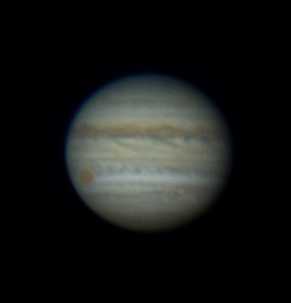
NAS member Glendon Howell took this image of Jupiter and its Great Red Spot with a webcam shooting through a Celestron C14 SCT on July 5, 2018 at 8:47 PM EDT.
Jupiter's Great Red Spot
 |
|
NAS member Glendon Howell took this image of Jupiter and its Great Red Spot with a webcam shooting through a Celestron C14 SCT on July 5, 2018 at 8:47 PM EDT. |
Revised 8/10/2018
Jupiter's Great Redspot, an atmospheric cyclone, is one of the best known features of our Solar System. It is believed that a spot observed by Hooke as early as 1664 may have been the GRS, making it one of the longest lived features ever observed. During the years of 1879-1882, the spot became such a striking red, it earned its present name.
A decade ago the GRS appeared as a colorless oval hollow, but has now recoved its red color. Jupiter rotates differentially, with its equatoral region rotating faster than its more temporate zones. The equatorial region rotates in 9 hours 50 minutes (System I), while the temporate latitudes that include the GRS rotate in 9 hours 55 minutes (System II).
An observer would think that the GRS would be visible during half of the period of rotation, but in reality, due to foreshortening effects when near the limb, it is actually only visible for about a 100 minute interval (50 minutes before to 50 minutes after the times listed below).
Red Spot at CM Longitude 290° (System II)
August 2018 (Times
are EDT)
1 06:46;16:42;
2 02:37;12:33;22:29;
3 08:25;18:20;
4 04:16;14:12;
5 00:08;10:04;19:59;
6 05:55;15:51;
7 01:47;11:42;21:38;
8 07:34;17:30;
9 03:26;13:21;23:17;
10 09:13;19:09;
11 05:05;15:00;
12 00:56;10:52;20:48;
13 06:44;16:39;
14 02:35;12:31;22:27;
15 08:23;18:18;
16 04:14;14:10;
17 00:06;10:02;19:57;
18 05:53;15:49;
19 01:45;11:41;21:36;
20 07:32;17:28;
21 03:24;13:20;23:15;
22 09:11;19:07;
23 05:03;14:59;
24 00:55;10:50;20:46;
25 06:42;16:38;
26 02:34;12:29;22:25;
27 08:21;18:17;
28 04:13;14:08;
29 00:04;10:00;19:56;
30 05:52;15:47;
31 01:43;11:39;21:35;